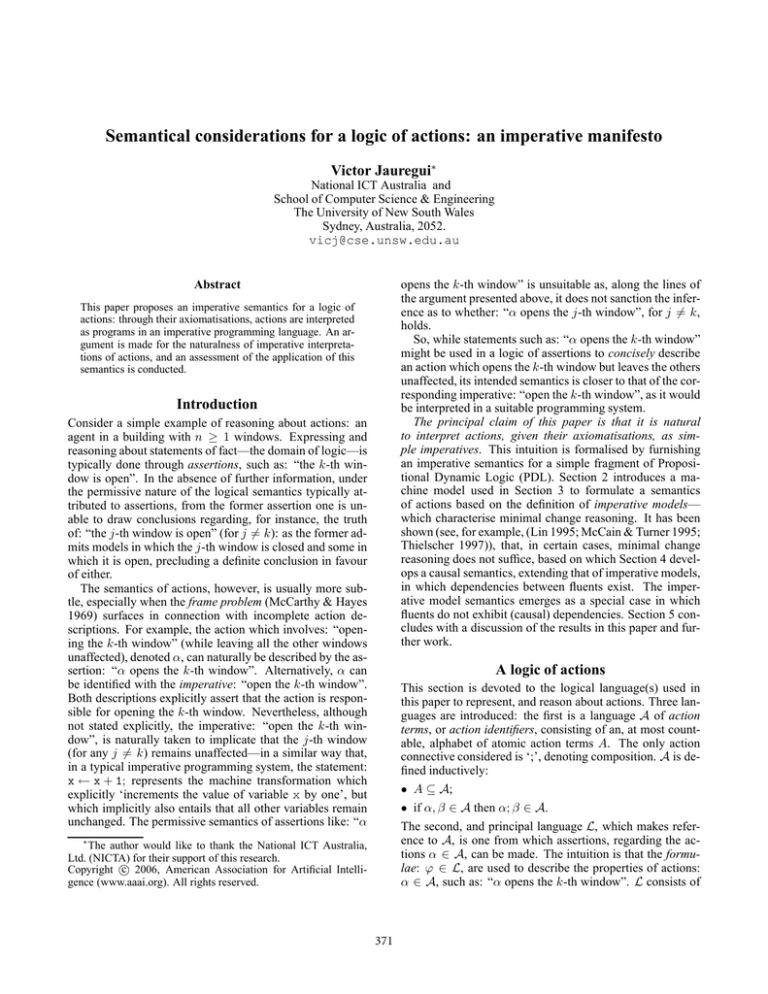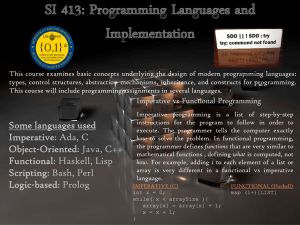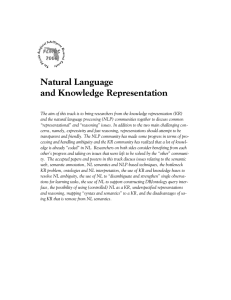
Semantical considerations for a logic of actions: an imperative manifesto
Victor Jauregui∗
National ICT Australia and
School of Computer Science & Engineering
The University of New South Wales
Sydney, Australia, 2052.
vicj@cse.unsw.edu.au
opens the k-th window” is unsuitable as, along the lines of
the argument presented above, it does not sanction the inference as to whether: “α opens the j-th window”, for j 6= k,
holds.
So, while statements such as: “α opens the k-th window”
might be used in a logic of assertions to concisely describe
an action which opens the k-th window but leaves the others
unaffected, its intended semantics is closer to that of the corresponding imperative: “open the k-th window”, as it would
be interpreted in a suitable programming system.
The principal claim of this paper is that it is natural
to interpret actions, given their axiomatisations, as simple imperatives. This intuition is formalised by furnishing
an imperative semantics for a simple fragment of Propositional Dynamic Logic (PDL). Section 2 introduces a machine model used in Section 3 to formulate a semantics
of actions based on the definition of imperative models—
which characterise minimal change reasoning. It has been
shown (see, for example, (Lin 1995; McCain & Turner 1995;
Thielscher 1997)), that, in certain cases, minimal change
reasoning does not suffice, based on which Section 4 develops a causal semantics, extending that of imperative models,
in which dependencies between fluents exist. The imperative model semantics emerges as a special case in which
fluents do not exhibit (causal) dependencies. Section 5 concludes with a discussion of the results in this paper and further work.
Abstract
This paper proposes an imperative semantics for a logic of
actions: through their axiomatisations, actions are interpreted
as programs in an imperative programming language. An argument is made for the naturalness of imperative interpretations of actions, and an assessment of the application of this
semantics is conducted.
Introduction
Consider a simple example of reasoning about actions: an
agent in a building with n ≥ 1 windows. Expressing and
reasoning about statements of fact—the domain of logic—is
typically done through assertions, such as: “the k-th window is open”. In the absence of further information, under
the permissive nature of the logical semantics typically attributed to assertions, from the former assertion one is unable to draw conclusions regarding, for instance, the truth
of: “the j-th window is open” (for j 6= k): as the former admits models in which the j-th window is closed and some in
which it is open, precluding a definite conclusion in favour
of either.
The semantics of actions, however, is usually more subtle, especially when the frame problem (McCarthy & Hayes
1969) surfaces in connection with incomplete action descriptions. For example, the action which involves: “opening the k-th window” (while leaving all the other windows
unaffected), denoted α, can naturally be described by the assertion: “α opens the k-th window”. Alternatively, α can
be identified with the imperative: “open the k-th window”.
Both descriptions explicitly assert that the action is responsible for opening the k-th window. Nevertheless, although
not stated explicitly, the imperative: “open the k-th window”, is naturally taken to implicate that the j-th window
(for any j 6= k) remains unaffected—in a similar way that,
in a typical imperative programming system, the statement:
x ← x + 1; represents the machine transformation which
explicitly ‘increments the value of variable x by one’, but
which implicitly also entails that all other variables remain
unchanged. The permissive semantics of assertions like: “α
A logic of actions
This section is devoted to the logical language(s) used in
this paper to represent, and reason about actions. Three languages are introduced: the first is a language A of action
terms, or action identifiers, consisting of an, at most countable, alphabet of atomic action terms A. The only action
connective considered is ‘;’, denoting composition. A is defined inductively:
• A ⊆ A;
• if α, β ∈ A then α; β ∈ A.
The second, and principal language L, which makes reference to A, is one from which assertions, regarding the actions α ∈ A, can be made. The intuition is that the formulae: ϕ ∈ L, are used to describe the properties of actions:
α ∈ A, such as: “α opens the k-th window”. L consists of
∗
The author would like to thank the National ICT Australia,
Ltd. (NICTA) for their support of this research.
c 2006, American Association for Artificial IntelliCopyright gence (www.aaai.org). All rights reserved.
371
The semantics of an instruction i is determined by how it
transforms a configuration w to produce the configuration
i
w′ , denoted: w −→ w′ . Using this notation, the operation
of the instructions λ and (k, b) is given by:
a simple fragment of PDL (c.f., (Pratt 1976)), sufficient for
the present discussion.
Let F be a finite set of atomic propositions, called fluents,
then L is inductively defined as follows:
• F ⊆ L;
• if ϕ ∈ L then ¬ϕ ∈ L;
• if ϕ, ψ ∈ L then ϕ → ψ ∈ L;
• if α ∈ A and ϕ ∈ L then [α]ϕ ∈ L.
All other connectives are regarded as abbreviations of these.
The modal formula: [α]ϕ, reads as: “after α terminates, ϕ
holds”, where α represents an action, process, or program.
The third language: P, consists of imperatives/programs.
The intuition is that an action identifier: α, based on its description in L, will correspond to some program in P, which
constitutes the action’s imperative interpretation. Before
proceeding further, the underlying machine: M; on which
P operates must be defined; its operation is as follows:
M consists of a one-way infinite tape (like a Turing
machine tape), with tape squares numbered 1, 2, . . . ,
and a program segment (possibly another tape) containing some program: p ∈ P. M proceeds by reading
an instruction from its program segment and modifying
the tape accordingly; the only primitives it can perform
on the tape are, for any i ≥ 0, setting the i-th tape
square to 0 or 1.
The language: P, which acts on M, is inductively defined:
• λ ∈ P;
• the pair (k, b) ∈ P, for every k ∈ N+ , b ∈ {0, 1};
• if p, q ∈ P then p; q ∈ P.
The instructions, or primitive operations, or sometimes just
primitives, of P are λ and pairs (k, b), for each k ∈ N+ ,
and b ∈ {0, 1}. λ denotes the null-op (the operation which
does nothing), while (k, b) denotes the operation of writing
symbol b at tape square k; these will be defined formally
later.
The members of P are called programs. It follows from
the definition above that a program: p; comprises a finite
sequence of primitives: p0 ; p1 ; · · · ; pn .1 The complexity of
program p is denoted |p|, and is defined inductively by:2
|λ| = 0
|(k, s)| = 1
λ
w −→ w
(k,b)
w −→ w′
where wj′ =
b
wj
if j = k;
otherwise.
In words, λ has no effect (i.e., it performs the identity
transformation), while the instruction (k, b) writes b at tape
square k (overwriting the previous value) but leaves all the
other tape squares unaffected.
A computation (in M) of program: p ∈ P; (with |p| = n)
from initial configuration w0 , is a sequence of configurapi
tions: w0 , w1 , . . . , wn , such that wi −→ wi+1 for each
i = 0, 1, . . . , n−1. Given initial configuration w0 , a computation is unique (M is deterministic). The transition correp
sponding to the computation of p from w0 , denoted w0 −→
pi
wn , constitutes the composition of each wi −→ wi+1 , for
0 ≤ i < n. As computations are deterministic the final conp
figuration v of a transition w −→ v is naturally represented
functionally as p(w) = v.
On the choice of machine model
While the machine model: M; and the corresponding language P used to program it are both very simple, this choice
of model exhibits a number of desirable features for reasoning about action. Firstly, the instructions allow for random
access to the tape, which overcomes some of the difficulties
encountered when Turing machines, with their local primitives, and generality, are used for a similar purpose (see
(Jauregui, Pagnucco, & Foo 2004)). M still affects only
local changes, in the sense that it only writes to one tape
square in a single instruction.
Ultimately, the final justification is that this formulation
allows for the results which appear subsequently in this paper, and which accord well with the motivations of commonsense reasoning about action. Further discussion will
be postponed until these results have been presented.
Action semantics
|p; q| = |p| + |q|.
With the underlying framework out of the way, this section
focuses on the development of a logical semantics of action.
Let L be a language containing n > 0 fluents: F =
{f1 , . . . , fn }; and some, at most countable, set of atomic
action identifiers: A; furnishing an action language: A; as
before. An L-structure is a triple (W, ν, µ); where W is
some set of abstract possible worlds, ν : F → 2W , termed a
valuation, assigns to each fluent the set of possible worlds in
which it holds, and µ : A × W → P maps an action term, in
a given world, to a program in P. µ(α, w) is referred to as
α’s imperative interpretation in w, and is further constrained
to programs: p ∈ P; such that p(w) ∈ W.
To meaningfully assign a program µ(α, w) to α, it must be
possible to associate with each w ∈ W an M-configuration.
A natural way to do this is to use ν to construct a string w
A configuration of the machine M (sometimes referred to
as an M-configuration) is any possible finite sequence of
symbols, represented as a string, that can appear on the machine’s tape: that is, a member of {0, 1}∗. The operation of
the machine is defined inductively as follows:
Execution of a program p0 ; p1 ; · · · ; pn , begins at step
i = 0 executing instruction p0 in the initial configuration w0 . If instruction pi is executed at step i then
instruction pi+1 is executed at step i + 1. The program
terminates at the first step i > n.
1
If w is a sequence or string then wi for i ∈ dom(w) denotes
the i-th element in w.
2
This is inspired by the concepts of Kolmogorov complexity (Li
& Vitanyi 1997).
372
such that:3
wk =
1
0
window remains closed. In this respect, this model is representative of the imperative semantics outlined earlier, reflecting the fact that Γ is to be interpreted as the imperative:
“open the k-th window”.
However, the semantics presented so far is unable to
reach the (desirable) conclusion that Γ |= ¬open(wj ) →
[a]¬open(wj ), for every j 6= k. To see this consider the
model with: µ(a, w) = (k, 1); (j, 1), for each w ∈ W; that
is, a is interpreted as opening both the k-th and j-th window.
Indeed, any interpretation for a which includes the instruction (k, 1) will produce a model of Γ. This permissiveness,
as with the semantics of assertions, makes it impossible to
conclude ¬open(wj ) → [a]¬open(wj ), for any j 6= k, from
Γ.
if w ∈ ν(fk );
otherwise.
A standard L-structure is an L-structure for which the
set of possible worlds W is (isomorphic to) a subset of nbit strings (given |F | = n), each corresponding to an Mconfiguration; that is, W ⊆ {0, 1}n. Because the possible
worlds in a standard structure carry the information regarding ν, when referring to a standard structure ν will often be
omitted: (W, µ). For notational convenience, when the language L, and hence F and n = |F |, is understood, then µ
alone will be used to identify the structure.
The satisfiability relation between a model µ, a formula
ϕ and a world w ∈ W , denoted µ |=w ϕ, is inductively
defined as follows:
µ |=w f
µ |=w ¬ϕ
µ |=w ϕ → ψ
µ |=w [α]ϕ
if
if
if
if
w ∈ ν(f );
(f ∈ F )
µ 6|=w ϕ;
when µ |=w ϕ, then µ |=w ψ;
µ |=µ(α,w)(w) ϕ.
Imperative models
Interpreting [a]open(wk ) imperatively by: “open the k-th
window”, as with an imperative programming language,
renders the additional implication: “. . . but leave the other
x’s as they were”,5 both natural and intuitive. More generally, this involves attributing to an action identifier: α;
the most primitive, or simplest interpretation p, measured
by its complexity |p|, consistent with its axiomatisation. In
this case the most primitive interpretation consistent with
[a]open(wk ) involves assigning to a the program (k, 1).
There is, however, one small consideration: if open(wk )
holds in the current world then nothing needs to be done
in order to open the window; for which λ is the most primitive and natural interpretation; in general, the interpretation
of an action depends on the world in which it is performed.
This is precisely why µ is a function of the action α ∈ A
and the world w ∈ W. The following definition formalises
this intuition.
An imperative model µ, of a formula ϕ ∈ L, in a world
w ∈ W, is a model of ϕ which, for each α ∈ A, there is
no model µ′ of ϕ which yields |µ′ (α, w)| < |µ(α, w|. In
words: an imperative model of ϕ, in a world w, is a standard
model which admits no simpler interpretation, for each α, in
w.
If µ is an imperative model of ϕ, in w, it is denoted µ |=Iw
ϕ. Moreover, µ is an imperative model of ϕ, denoted µ |=I
ϕ, if it is an imperative model of ϕ in every w ∈ W. A
model µ is an imperative model of a set of formulae Γ ⊆ L,
denoted µ |=I Γ, if it is an imperative model of each ϕ ∈
Γ. A formula ϕ is an imperative consequence of a set of
formulae Γ, denoted Γ |=I ϕ if every imperative model of
Γ is a model of ϕ.
For the windows example it can be observed that the
model:
(k, 1) if wk 6= 1;
µ(a, w) =
(3)
λ
otherwise,
(1)
Moreover, µ is a model of ϕ if for every w ∈ W, µ |=w ϕ.
If Γ ⊆ L is a set of formulae then µ is a model of Γ if
it is a model of every ϕ ∈ Γ; that is µ |= ϕ, for every
ϕ ∈ Γ. All structures must interpret actions according to the
corresponding standard model criterion of PDL; namely:4
µ(α; β, w) = µ(α, w); µ(β, µ(α, w)(w)).
(2)
Let Γ ⊆ L be a set of formulae, and ϕ ∈ L a formula,
then ϕ is a logical consequence of Γ, denoted Γ |= ϕ, if
every standard model of Γ is a model of ϕ.
Action theories
Consider again the windows example that was outlined earlier. The language for this example consists of fluents F =
{open(wj ) | 1 ≤ j ≤ n}, for n > 1, designating a fluent
to capture whether or not each window is open; and a single
atomic action A = {a}, which is intended to correspond to
the action of: “opening the k-th window”. For this example
all standard models have W = {0, 1}n.
A natural axiomatisation for action a in this example is:
Γ = {[a]open(wk )}, indicating that: “action a opens the
k-th window”. Consider the model with µ(a, w) = (k, 1),
for each w ∈ W; i.e., the model in which a is interpreted,
for any window configuration/world, as the program which
opens (only) the k-th window: that is, setting the k-th tape
square to 1.
For this model, µ |= ¬open(wj ) → [a]¬open(wj ), for
any j 6= k; that is, in any initial world in which the j-th
window is closed, after opening the k-th window, the j-th
is an imperative model of Γ. In fact, a standard model can
be shown to be unique modulo the concatenation of λ’s and
permutations of instructions. In view of this, when a model
is given it will often represent the equivalence class of all
such interpretations.
3
That is, with each world: w ∈ W; is associated the string with
a 1 at the k-th position if the k-th fluent: fk ; holds, and 0 otherwise.
4
This simply states that, if α is mapped to program p in world
w and β is mapped to program q in world p(w), then α; β must
be mapped to p; q in w. In this way, when the mapping µ(a, w) is
determined for all atomic action identifiers a ∈ A, then µ(α, w) is
uniquely determined for all α ∈ A.
5
373
Here the x’s stand for windows.
Assessment
In this example the gun is always loaded but the turkey,
in addition to being alive (a), may be walking (w). The
dependency/constraint exists which states that only walking turkeys may be alive. This yields: A = {Sh}, F =
{a, w} and Γ = {[Sh]¬a, w → a}. Standard models of
Γ will have W = {aw, aw, aw}—note that aw ∈
/ W, as it
violates the constraint w → a.
The point needs to be made that, while the semantics permits only programs with transitions which take worlds from
W to other worlds in W, it does not prohibit transitions involving computations which traverse (but do not terminate
in) configurations not in W.
Le µ be an imperative model for Γ, satisfying:
A preliminary characterisation of this semantics can already
be made, but before supplying this, an assessment is presented based on collections of pairs (Γ, ϕ) with respect to
which the present semantics, that is, the relation Γ |=I ϕ,
acquits itself intuitively.
Simple examples The first Γ is that of the windows example discussed so far. From the discussions in the preceding section it can be observed that, for any j 6= k,
Γ |=I ¬open(wj ) → [a]¬open(wj ). The proof involves
consideration of the two cases in (3), and the observation
that the semantics given by (1) is determined by a program’s
transitions; making it invariant under the addition of superfluous λ’s to an action’s interpretation and the permutation
of instructions.
Another example is the Yale Shooting Problem (YSP)
(taken from (Hanks & McDermott 1987)). In this example,
there is a turkey and a gun, which may or may not be alive
(fluent a) and loaded (fluent l), respectively. The actions
are: to “Load” (Lo) the gun, after which it will be loaded; to
“Shoot” (Sh) the turkey with the gun, after which, if the gun
was loaded the turkey will be dead; and finally the action
“Wait” (W a) which involves doing nothing, and hence requires no axiomatisation: whence, A = {Lo, W a, Sh}, and
F = {a, l}, with axiomatisation Γ = {[Lo]l, l → [Sh]¬a}.
For perspicuity, a mapping between a fluent: f ∈ F and
its corresponding tape square in a standard structure will be
used. So, for instance, the program instruction (f, 1) denotes
setting the tape square corresponding to fluent f to 1.
It is expected that after loading, waiting, and then shooting the gun, the turkey should be dead; that is, Γ |=I
[Lo; W a; Sh]¬a. Consider an imperative model µ, then:6
(l, 1) if w ∈
/ ν(l);
µ(Lo, w) =
λ
otherwise,
µ(W a, w) = λ
∀w ∈ W;
(a, 0) if w = al;
µ(Sh, w) =
λ
otherwise.
µ(Sh, aw)
µ(Sh, aw)
µ(Sh, aw)
= λ;
= (a, 0);
= (a, 0); (w, 0).
The corresponding transitions induced by these interpretations p, are, for:
p=λ:
p = (a, 0) :
p = (a, 0); (w, ) :
p(aw) =
p(aw) =
p(aw) =
aw;
aw;
aw.
Note, in particular, that µ(Sh, aw) = (a, 0); (w, 0), tra/ W, which due to the constraint
verses world w′ = aw ∈
w → a, induces the additional transformation (w, 0) to ensure that p(aw) ∈ W.
This analysis indicates that the framework proposed so
far furnishes a faithful characterisation of a solution to the
frame problem based on the principle of minimal change,
overcoming some of the problems encountered by other approaches, e.g., naively applying circumscription (McCarthy
1980) to solve the Yale Shooting Problem (for an overview
see (Shanahan 1997)). It has been noted in the literature,
however, that sometimes fluents exhibit extra-logical dependencies (see (Lifschitz 1990), (Lin 1995), (McCain & Turner
1995), (Thielscher 1997)); e.g., causal dependencies. A
framework for reasoning about action must acquit itself of
these to be deemed adequate. The problem will be outlined
below; the solution will be left to the next section.
By the standard model property (2), the following obtains:
(l, 1); λ; λ
if w = al;
(l,
1);
λ;
(a,
0)
if w = al;
µ(Lo; W a; Sh, w) =
λ;
λ;
λ
if w = al;
λ; λ; (a, 0)
if w = al.
Examples with non-logical dependencies Consider an
electrical circuit containing two switches (sw1 and sw2 )
connected in series to a power source (possibly a battery)
and a light (l): F = {sw1 , sw2 , l}.7 The only action considered is: “closing switch sw1 ”, denoted C1 : A = {C1 }. The
system can be axiomatised by: Γ = {[C1 ]sw1 , sw1 ∧sw2 ↔
l} . It would be desirable to obtain Γ |=I ¬sw1 ∧ sw2 →
[C1 ]l: for example, in the world w = sw1 , sw2 , l, in which
the first switch is off, the second is on, and, therefore, the
light is off, if the first switch is closed (switched on) then it
should be inferred that the light turns on.
The following can be shown to be an intended imperative
model of Γ:
(
λ
if w ∈ ν(sw1 );
(sw1 , 1)
if w ∈
/ ν(sw2 );
µ(C1 , w) =
(sw1 , 1); (l, 1) otherwise.
For each of these interpretations it can readily be observed,
by inspection, that, in the given state w, the corresponding program p (e.g., p = (l, 1); λ; λ in w = al) yields
µ |=Ip(w) ¬a. Consequently, for every w ∈ W, µ |=w
[Lo; W a, Sh]¬a, and hence Γ |=I [Lo; W a; Sh]¬a.
Examples with logical dependencies The windows and
YSP examples do not impose any restrictions on possible
worlds: no logical constraints exist between the fluents.
A modification of the YSP, taken from (McCain & Turner
1995), introduces such dependencies.
6
/
Here, the notation w = al, denotes that w ∈ ν(a) and w ∈
ν(l); i.e., w ∈ ν(a) ∩ ν(l).
7
374
This example is taken from (Thielscher 1997).
This model satisfies µ |=I ¬sw1 ∧sw2 → [C1 ]l. However, it
can be shown that the following is an anomalous/unintended
model of Γ:
(
λ
if w ∈ ν(sw1 );
′
(sw1 , 1)
if w ∈
/ ν(sw2 );
µ (C1 , w) =
(sw1 , 1); (sw2 , 0) otherwise.
α ∈ A, and w ∈ W, over all standard models of (Γ, R).
Intuitively, a causal model is one which assumes as few
independencies as possible. For R = ∅; i.e., where no
dependencies between fluents exist, it can be shown that
causal models reduce to imperative models: observe that
δ(λ) = 0 = |λ|; and δ(p) = n = |p|; the proof follows by
induction. This result is pleasing in that it naturally incorporates imperative models, and hence minimal-change reasoning, with scenarios in which no extra-logical dependencies
are considered (i.e., the case where R = ∅).
Returning to the switches example presented earlier, it can
now be seen that the causal model criteria means that, with
R = {(sw1 , l), (sw2 , l)}, the causal theory (Γ, R), with Γ
as before yields, for w = sw 1 , sw2 , l, that δ(µ(Sh, w)) <
δ(µ′ (Sh, w)). So, the intended model µ is preferred over the
anomalous model µ′ , as it warrants fewer independencies.
The approach taken here, incorporating a relation of dependence, is reminiscent of that of (Thielscher 1997) who
adopts an ‘influence relation’ which captures a similar intuition. The necessity for an appeal to some such notion is
suggestive; although it may be possible to incorporate the
dependencies in R by suitably extending the language and
axiomatisation, doing so likely involves an overhead such
as to make it prohibitive. The approach presented obviates
such concerns by making the dependency consideration a
separate component of a causal theory.
The latter model entails that sw2 mysteriously opens and,
hence, that µ′ 6|=I ¬sw1 ∧ sw2 → [C1 ]l; making it the case
that Γ 6|=I ¬sw1 ∧ sw2 → [C1 ]l. The problem with the latter model—the reason it defies our intuitions—is that, given
background knowledge of the domain, while it is natural to
associate a dependency between sw1 and l, the switches sw1
and sw2 are independent of each other in this example; making it counterintuitive for sw2 to change as a result of affecting sw1 . In the next section this argument is formalised to
generalise the imperative semantics so far developed into a
causal semantics.
Causal semantics
The intuition this section intends to capture is that, along
with any logical dependencies imposed by the constraints
on a domain axiomatisation Γ, there may be additional, nonlogical dependencies between fluents, as might be captured
with a binary relation R ⊆ F × F . So, for example, in the
switches example outlined earlier it is natural to attribute a
dependency of fluent l on both sw1 and sw2 , but no other;
in which case, R = {(sw1 , l), (sw2 , l)}.
In this respect, the anomalous model presented earlier:
µ′ (C1 , (sw 1 , sw2 , l)) = (sw1 , 1); (sw2 , 0), is less feasible
as the succession of affected fluents in this interpretation:
sw1 , sw2 ; do not exhibit a dependency, in contrast with the
pair sw1 , l, endorsed by the intended model, which does exhibit a dependency under R. The following formalises this
intuition.
A causal theory is a pair (Γ, R), where Γ ⊆ L is a
logical theory and R ⊆ F × F is a relation of dependence among fluents. Let p ∈ P be a program where
p = (fg(1) , b1 ); · · · ; (fg(n) , bn ).8 The causal sequence of
fluents corresponding to p consists of fg(1) , . . . , fg(n) . With
a program p ∈ P is associated a function δ : P → N which
assigns to p the number, δ(p), of independencies of p. The
function δ is defined (for p = (fg(1) , b1 ); · · · ; (fg(n) , bn ) 6=
λ) by:
δ(λ) =
δ(p) =
Conclusion
Summarising, this paper presents a system for reasoning
about actions reflecting the intuition that a natural semantics for incomplete action descriptions is that of imperatives; as with statements of typical imperative programming languages. One of the central themes that this paper addresses is the view that the most plausible commonsense inferences an agent makes are often the simplest feasible conclusions; in the context of actions, under an imperative semantics, this means the simplest programs/processes/transformations. This perspective is also
entertained by (Jauregui, Pagnucco, & Foo 2004). The
present treatment is less ambitious but arguably better tailored to the concerns of commonsense reasoning about actions. It shares commonalities with the work of (Zhang &
Foo 2001) on extending PDL for reasoning about actions;
however, their approach to the frame problem is syntactic (a
form of lazy evaluation of frame axioms) leaving their semantics for the frame problem unclear. The present paper
borrows many intuitions and has benefitted from the work
of (Łukaszewicz & Madalinńska-Bugaj 1995) and (Meyer
& Doherty 1999).
In similitude with Thielscher’s work on inferring causal
ramifications (Thielscher 1997), Halpern and Pearl’s work
on actual causation (see (Halpern & Pearl 2001)) incorporates the notion of dependence between fluents through their
causal/structural models. The latter’s concerns are largely
distinct with the ones of this paper, but it is encouraging
that the notion of dependence resonates in both; lending support to the incorporation of a relation of dependence in the
present work. (Castilho, Gasquet, & Herzig 1999) also uses
0;
1 + |{(fg(i) , fg(i+1) ) ∈
/ R | 1 ≤ i < n}|.
In words, an ‘independence’ instance exists for every pair
(fg(i) , fg(i+1) ), for 1 ≤ i < n, in the causal sequence corresponding to p, which does not occur in the dependency
relation R; the extra one accounts for the effect of the action
on the first fluent, which is always assumed independent—
an action is always assumed to be initiated in a stable world;
that is, a world in which no active causal forces are immediately in operation.
A causal model of a causal theory: (Γ, R); is an imperative model of Γ which minimises δ(µ(α, w)), for each
8
Here g yields a permutation of 1, . . . , n.
375
for programming languages: preliminary report. In Mellish
(1995), 1950–1955.
McCain, N., and Turner, H. 1995. A causal theory of
ramifications and qualifications. In Mellish (1995), 1978–
1984.
McCarthy, J., and Hayes, P. 1969. Some philosophical
problems from the standpoint of artificial intelligence. Machine intelligence 4:463–502.
McCarthy, J. 1980. Circumscription—a form of nonmonotonic reasoning. Artificial intelligence 13:27–39.
Mellish, C., ed. 1995. Proceedings of the 14th international conference on artificial intelligence. Morgan Kaufmann.
Meyer, J.-J. C., and Doherty, P. 1999. Preferential action semantics (preliminary report). In Formal Models of
Agents, 187–201. Berlin: Springer.
Pratt, V. R. 1976. Semantical considerations on FloydHoare logic. In IEEE Symposium on Foundations of Computer Science, 109–121.
Sandewall, E. 1994. Features and Fluents. Oxford university press.
Shanahan, M. 1997. Solving the frame problem: a mathematical investigation of the common sense law of inertia.
Cambridge, MA, USA: MIT Press.
Thielscher, M. 1997. Ramification and causality. Artificial
intelligence 89(1–2):317–364.
Zhang, D., and Foo, N. Y. 2001. EPDL: A logic for causal
reasoning. In Proceedings of the 17th International Joint
Conference on Artificial Intelligence, 131–138.
a dependence relation to address the frame problem, however, their relation is between action and fluents; in contrast,
the present paper takes dependencies between fluents as the
fundamental relation.
A shortage of space prohibits an adequate discussion of
the limitations of the system presented here—a number of
which the author has already identified. One of the more
notable omissions regards the simplicity of the languages
used, both A and L, as well as P. Indeed, it is largely
due to the restrictions on A (and hence, P) that the framework is so sympathetic to the principle of minimal change.
If space limitations have prevented it from being conveyed
adequately in the text, it is the principle of simplicity which
this paper regards as the more fundamental of the two with
respect to commonsense reasoning. Here the complexity of
(the interpretation of) an action is the key notion. In this
respect, this paper constitutes a preliminary step to a more
comprehensive account of the role of simplicity/complexity
in commonsense reasoning.
Ultimately, a more systematic analysis approaching the
rigour of (Sandewall 1994) needs to be conducted to ascertain where this framework sits in comparison to the many
others that exist for commonsense reasoning about actions;
an investigation which is already underway.
Acknowledgements
The author would like to thank the KR 2006 reviewers for
their comments and suggestions. Special mention is reserved for Tri Minh Cao and Patrick Caldon for their helpful
feedback and suggestions on earlier drafts of this paper.
References
Castilho, M.; Gasquet, O.; and Herzig, A. 1999. Formalizing action and change in modal logic I: the frame problem.
Journal of Logic and Computation 9:701–735.
Halpern, J. Y., and Pearl, J. 2001. Causes and explanations: A Structural-Model approach: Part 1: Causes. In
Breese, J., and Koller, D., eds., Proceedings of the 17th
Conference on Uncertainty in Artificial Intelligence (UAI01), 194–202. Morgan Kaufmann.
Hanks, S., and McDermott, D. 1987. Nonmonotonic logic
and temporal planning. Artificial intelligence 33:379–412.
Jauregui, V.; Pagnucco, M.; and Foo, N. 2004. On the intended interpretations of actions. In Zhang, C.; Guesgen,
H. W.; and Yeap, W.-K., eds., Proceedings of the 8th pacific rim international conference on artificial intelligence,
volume 3157 of Lecture Notes in Computer Science, 13–
22. Springer.
Li, M., and Vitanyi, P. M. B. 1997. An Introduction
to Kolmogorov Complexity and Its Applications. Berlin:
Springer-Verlag, 2nd edition.
Lifschitz, V. 1990. Frames in the space of situations (research note). Artificial intelligence 46(3):365–376.
Lin, F. 1995. Embracing causality in specifying the indirect
effects of actions. In Mellish (1995), 1985–1991.
Łukaszewicz, T., and Madalinńska-Bugaj, E. 1995. Reasoning about action and change using dijkstra’s semantics
376







